In August 2020, I reviewed the Hegel Music Systems H95 integrated amplifier-DAC for this site. If you read that review, you’ll know that the H95, which is priced at $2000 (all prices in USD), is a good performer and good value, but you’ll also see it’s not as feature-rich as some other integrated amps on the market. For example, like all of Hegel’s integrated amplifiers, it has a built-in DAC but lacks a phono stage. Vinyl playback is a pretty big thing for hi-fi buyers across all price ranges, and many lower-priced integrated amps answer that demand, so I intended to criticize this omission in the review.
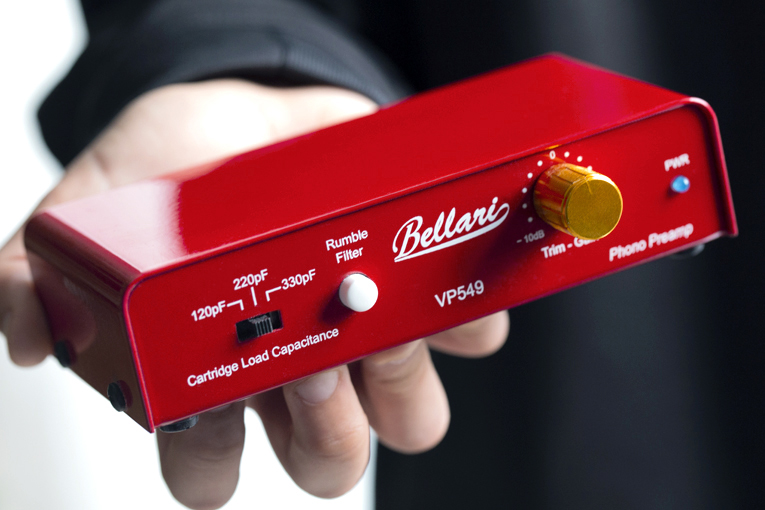
But before I put pen to paper on that point and moved on, I whipped out a Bellari VP549 RIAA phono stage ($149) that I had ordered from Amazon and hooked it up to one of the Hegel’s single-ended inputs with some inexpensive, discontinued Axiom Audio interconnects. When I played music through it from my Pro-Ject Audio Systems X1 turntable with Pick it S2 moving-magnet cartridge, I was genuinely surprised by the quality of sound that came from the speakers, and this made me rethink how important it is for an integrated amplifier to have a built-in phono stage. So right after that review was done, I decided to seek out more inexpensive external phono stages and do some more listening. The first one to arrive at my place was the NAD PP 2e ($189). It and the VP549 are the subjects of this month’s “System One” article.
Descriptions
Bellari products are made in the USA by Rolls Corporation, which is located in Salt Lake City, Utah. On its website, Rolls describes itself as “an innovative audio electronics manufacturer specializing in mixers, amplifiers, signal processors and signal sources.” Although hi-fi consumers can certainly buy Rolls products, the things the company makes seem more directed at the pro audio community. Bellari, on the other hand, is a subsidiary of Rolls that is more consumer oriented, with products catering mostly to turntable and headphone enthusiasts. On the Bellari website is this statement: “Bellari incorporated in 1989 with a clear objective to re-establishing the relevance of ‘made in the USA’ with the highest quality hand built, affordable, audio equipment for regular consumers without bottomless wallets.”
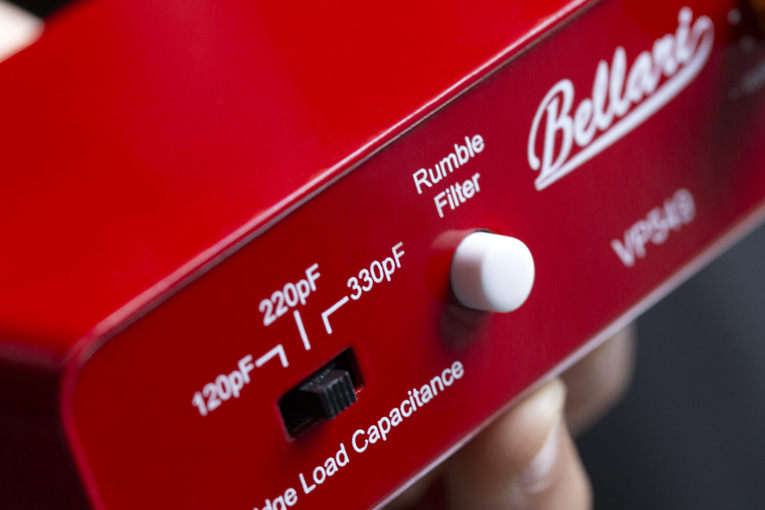
The VP549 has, to my eyes, wonderful styling—in fact, so wonderful that when I was browsing on Amazon, its appearance helped sway me to buy it over the plethora of inexpensive phono stages you can find there, which, in comparison, looked rather blah. Its diminutive, sturdy, all-metal case measures just 5.5″W × 1.5″H × 2.75″D (excluding the front knob, switches, connectors, and feet) and has a top that curves around both sides and juts out a bit over the front plate. Like many of the Bellari products, the VP549 has an eye-catching bright-red paint job, which, in combination with the curvy case and retro control knobs, gives it a very cool 1950s vibe.
The case of NAD’s PP 2e is similar in size to the VP549—it measures about 5.3″W × 1.3″H × 2.9″D—and it too is all metal with a sturdy feel. However, the PP 2e is rectangular in shape and black in color, and with its unobtrusive front-panel power button it’s far plainer looking than the VP549. In fairness, that no-nonsense, utilitarian look has been a hallmark of the NAD brand and definitely seems to be what the company’s customer base likes.
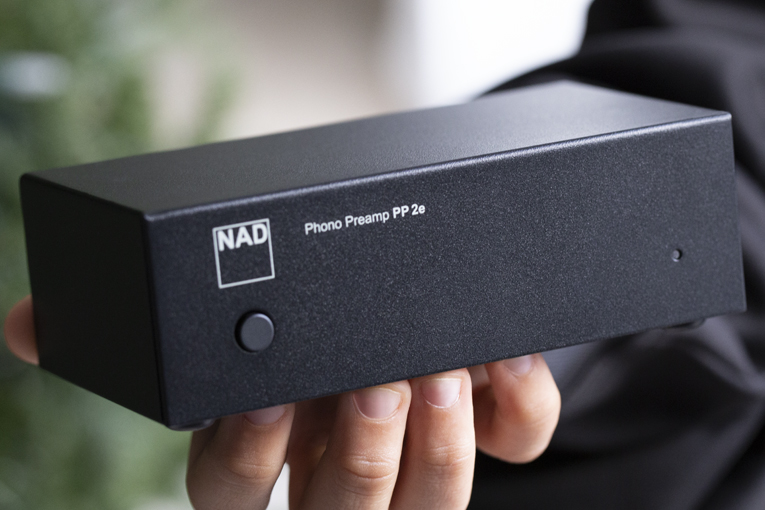
Unlike the NAD PP 2e, which supports both moving-magnet (MM) and moving-coil (MC) cartridges via dual single-ended RCA inputs and a selector switch on its back panel, the VP549 only accommodates MM cartridges. But whereas the NAD’s gain is fixed at 34dB for MM and 58dB for MC, the gain setting on the VP549 for MM is variable from 31.64dB to 45.66dB, depending on where you set the gold-colored, front-panel-mounted Trim - Gain knob, which is labeled -10dB and +4dB at the extreme ends of its range. That provision for adjustment could be handy for matching it to certain cartridges or linestage preamp sections.
There are also other differences, which could certainly sway someone to prefer one or the other on features alone. For instance, the VP549 has variable capacitance settings of 120, 220, and 330pF, which the NAD doesn’t have—capacitance is fixed at 200pF for MM and 180pF for MC. But both phono stages have a fixed input impedance of 47k ohms for MM cartridges, which is typical (and the NAD’s impedance for MC is 100 ohms, which is also standard). The VP549 has a low-frequency filter—labeled Rumble Filter, and activated by a white pushbutton on the front panel—to cut out the very low frequencies that, for a variety of reasons, can emanate from a turntable. This “rumble” can cause bass drivers to overexert, and the NAD doesn’t have this feature. On its back panel, the VP549 also has a 1/8″ jack that is labeled Headphone/Line Output in the picture on the company’s website, but on my unit is labeled Stereo Output. The latter is likely more accurate because its usefulness with headphones is limited—the Trim - Gain knob on the front panel acts as a volume control but only offers 14dB of latitude.
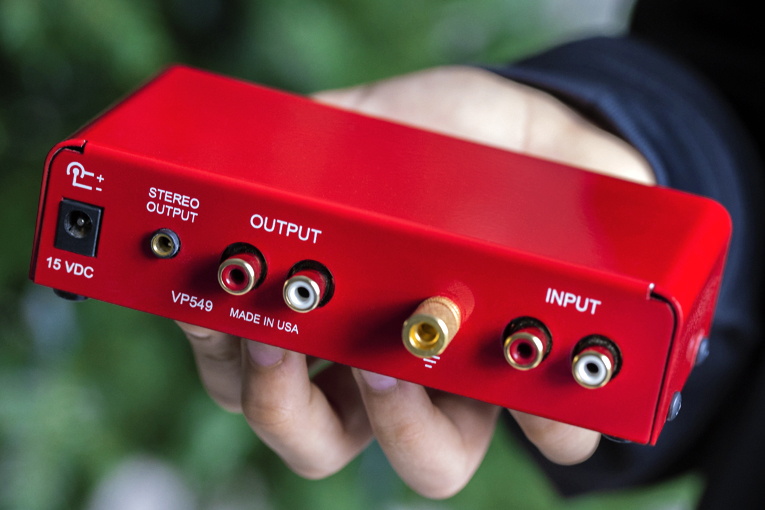
Both phono stages have a ground connector on the rear panel, which you typically need for the ground wire on your phono cable, as well as a jack for an external “wall wart” power supply. But only the NAD has a power button (in fact, it’s the only control on the front panel)—the VP549 just turns on the moment you plug it in, which you’ll be aware of because the front-mounted LED glows a bright blue.
Spec-wise, Bellari claims a 3Hz to 36kHz bandwidth for the VP549, with its RIAA EQ correction curve (necessary for vinyl playback) coming within a +/-1dB window from 14Hz to 23kHz. Bellari also claims a >94dB unweighted signal-to-noise ratio, though no frequency range is given for that spec. NAD doesn’t claim an overall frequency bandwidth for the PP 2e, but the literature does specify an “A weighted, with cartridge connected” signal-to-noise ratio of 80dB, again without a frequency range, and an RIAA deviation of +/-0.3dB. Even though it’s not specified, I’d have to assume this is for 20Hz to 20kHz, which is the audioband for human hearing. But since these specifications aren’t under the same conditions, it’s impossible to compare apples to apples with these units, so I thought it best to get down to listening.
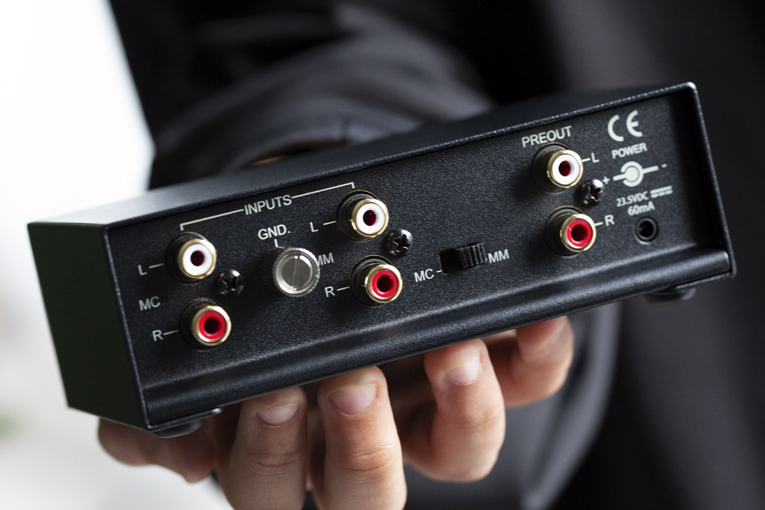
Sounds
When I listened to the Hegel H95 with the Bellari VP549, it was in my System One setup, which, for over a year, has had the Pro-Ject X1 turntable I mentioned and QED XT25 speaker cables in it the entire time. The speakers have varied quite a bit, mind you. At that moment, I was using a pair of NHT C 3 Carbon Fiber stand-mounts on 24″ Monoprice Monolith stands. The X1 was connected to the Bellari via Pro-Ject’s Connect it E phono cable, which comes stock with the X1, and from the Bellari to the Hegel were the Axiom Audio interconnects I mentioned. Both sets of interconnects were chosen because I want to keep the cost of adding an external phono stage as low as possible. The VP549 capacitance was set to 220pF, though I didn’t find any appreciable difference between that and 120 and 330pF selections. The Trim - Gain knob was set to 0, which seemed to provide enough output for the Hegel.
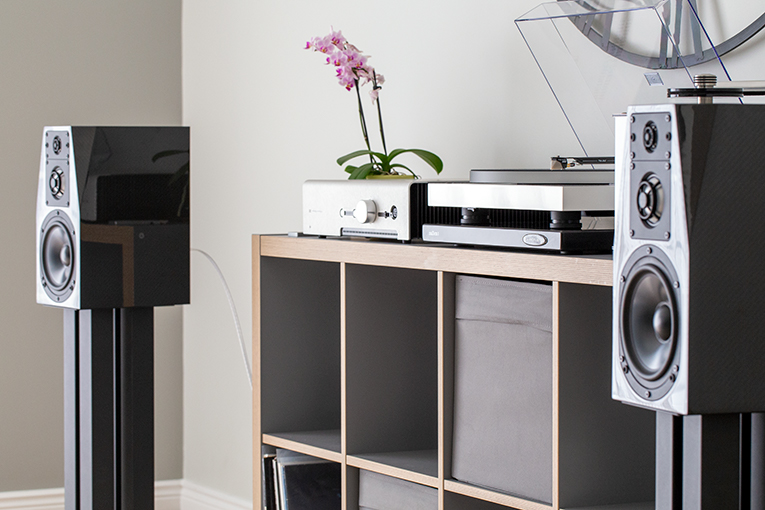
Up until that time, I had been using a Schiit Audio Ragnarok 2 Fully Loaded integrated amp (which includes a phono stage and DAC) for my “System One” reviews of other products since I wrote about it in April 2020. But it was temporarily out of the picture because I’d loaned it to our YouTube reviewer, Jay Lee, so he could make a Take 2 episode about it, which is why I could easily slide the H95 in. And in that H95 review I wrote this:
I played side 1 of Dire Straits’ Communiqué (LP, Mercury SRM-1-3791), and was blown away. . . . the sound was much clearer than what I’m used to from the Ragnarok 2 Fully Loaded’s built-in phono stage, for just $350 more. Mark Knopfler’s voice, in particular, was not only more prominent in the mix, its delineation from the instruments was much easier to hear than through the Schiit. Pick Withers’s cymbals, too, sounded clearer, airier, more prominent, as did Knopfler’s finger-picked guitar notes. I also noticed that the soundstage depth was more obvious than I’d heard before, particularly in “News,” in which Knopfler’s voice is forward on the stage, and the drums seemed to be about 10′ back.
I’d also played Bryan Ferry’s Boys and Girls (LP, Warner Bros. 25082 1) and heard similar qualities from the VP549, so shortly after I’d finished with the H95 review, I got the Ragnarok 2 Fully Loaded back from Jay so I could directly compare the sounds of the X1 connected to the Fully Loaded’s built-in phono stage against the X1 connected to one of the single-ended inputs on the Fully Loaded via the VP549. I left the Trim - Gain knob on the VP549 at 0.
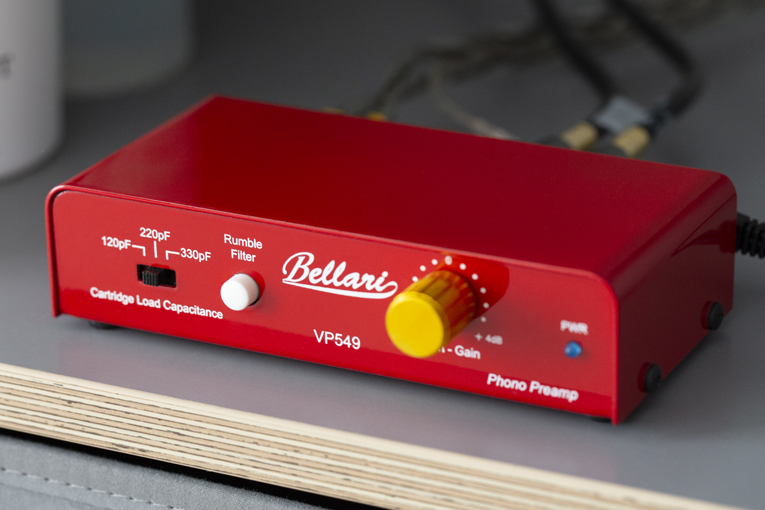
To conduct these tests, I played a variety of LPs, including the ones listed above once again (and again and again), and although the differences between the sounds of the two phono stages weren’t night and day, they differed enough to be meaningful to serious enthusiasts. Overall, I thought that the Schiit’s phono stage had a very balanced sound from the bass through the highs, and that it brought forth quite a bit of the detail in the recordings. All told, it was hard to fault as there was nothing inherently “wrong” with its sound. But I thought midrange sounds, such as vocals, “popped” a little more through the VP549, which I really liked. This was evident on vocal-dominated recordings such as Bruce Springsteen’s Tunnel of Love (LP, Columbia Records COC 40999), which I often use in my reviews for its good overall recording quality. I also found that the VP549 sounded a touch cleaner and more detailed, as well as a little more dynamic. This was not only evident on Tunnel of Love, but on all the LPs I played through it, which made the music more enjoyable to listen to because it sounded more spirited. Unfortunately, I couldn’t tell much about the deep bass because the NHT speakers cut off pretty quickly below 60Hz.
Around this time, the NAD PP 2e also arrived and I threw it into the same mix, and after some rounds with the NHT speakers, I also brought in the Q Acoustics 3030i stand-mount loudspeakers that I wrote about last May to see if a speaker swap would change any impressions. For the most part, swapping the speakers didn’t change any outcomes. For example, the clarity, midrange “pop,” and higher detail that the VP549 conveyed compared to the Schiit’s built-in phono stage transferred over with the Qs. But because these speakers reach lower in the bass than the NHTs do, I was now able to ascertain that the Schiit’s own phono stage and the NAD PP 2e seemed to convey a little more bass weight than the VP549 did.
I also noticed that, throughout the audioband, the Schiit’s built-in phono stage and the NAD PP 2e sounded similar, whereas, as I mentioned, the Bellari VP549 seemed to have a slight midrange prominence, and this was the main reason it sounded so different from the other two. But while I liked the sound of the VP549 over that of the Schiit’s built-in phono stage, mostly because it sounded livelier and more detailed and had that midrange “pop,” it was really a toss-up between the sounds of the VP549 and the PP 2e. The latter was definitely more detailed sounding—it let me hear into the recordings better. This was even more noticeable when I went back to the NHT C 3 Carbon Fibers, which, despite their lack of bass, reveal recorded nuances better than the Q Acoustics 3030i stand-mounts can.
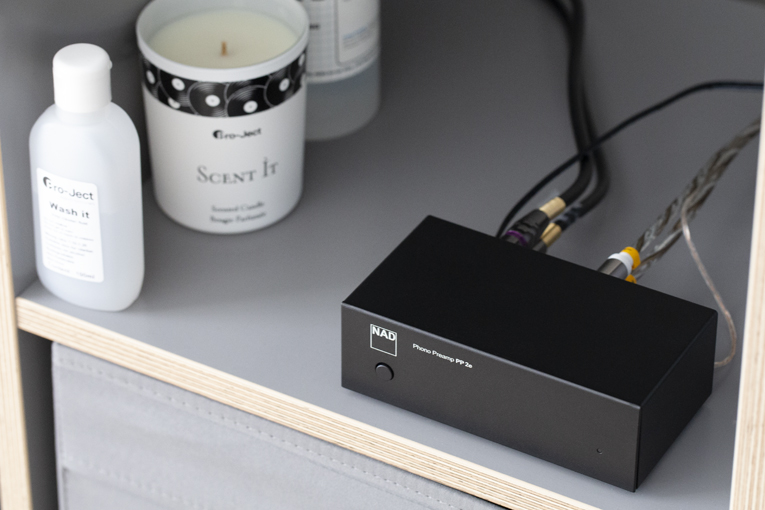
Hearing the NAD consistently sound more detailed than the other two phono stages, I followed up with a nonmusical test. With no music playing, only the phono stage turned on, and the Ragnarok 2 Fully Loaded’s volume turned high, I listened to the tweeter of one of the C 3 Carbon Fibers from about an inch away for each phono stage and found that they all gave off quite a bit of self-noise, but the NAD PP 2e was the least noisy of the bunch. However, it should be said that the hiss, even from the noisiest phono stage (the Bellari VP549), wasn’t really a deterrent when music began playing, because even the surface noise from an LP would drown it out. Still, I couldn’t help but wonder if that lower noise contributed to the increased detail I heard in the recordings when I played them via the NAD. Perhaps the measurements that I have asked Diego Estan to perform on the VP549 and PP 2e using our Audio Precision APx555 analyzer will reveal something more about their noise performance, as well as the subtle differences I heard in the sounds of these phono stages.
Recommendations
Insofar as the Bellari VP549 and NAD PP 2e phono stages go, for me, there’s no clear winner. After making the observations I’ve documented here, I’ve swapped between the two phono stages with my Pro-Ject X1 turntable and Pick it S2 MM cartridge for the last few months and can’t decide which one is better, since both have strengths and weaknesses. But I can point out some things that might help you. For example, if you only have an MM cartridge and you want the cheapest price, Bellari’s VP549 could be the best choice, particularly if you put value on its styling and/or you want the adjustable capacitance settings. It also has that bit of midrange prominence, which can sound good, though it seems to have less bass weight than the NAD. But if you already use an MC cartridge, or think you may purchase an MC someday and don’t want to be forced to get a new phono stage for it, NAD’s PP 2e becomes the more obvious choice. The NAD is also quieter, though with the inherent noisiness of vinyl, it’s hard to say how much that matters. Those are a few things to think about.
For me, the biggest takeaway has been what I discovered when I reviewed the Hegel Music Systems H95—it might not matter if an integrated amplifier or a standalone preamplifier lacks a built-in phono stage since good ones like the Bellari VP549 and NAD PP 2e can be had for so little. And there are more than just these two options to consider—some inexpensive phono stages have just arrived and I’ll be exploring them in future “System One” columns, so please keep checking back in the months to come.
. . . Doug Schneider
das@soundstagenetwork.com
Note: for the full suite of measurements on the Bellari VP549 from the SoundStage! Audio Electronics Lab, click this link.
Note: for the full suite of measurements on the NAD PP 2e from the SoundStage! Audio Electronics Lab, click this link.






















